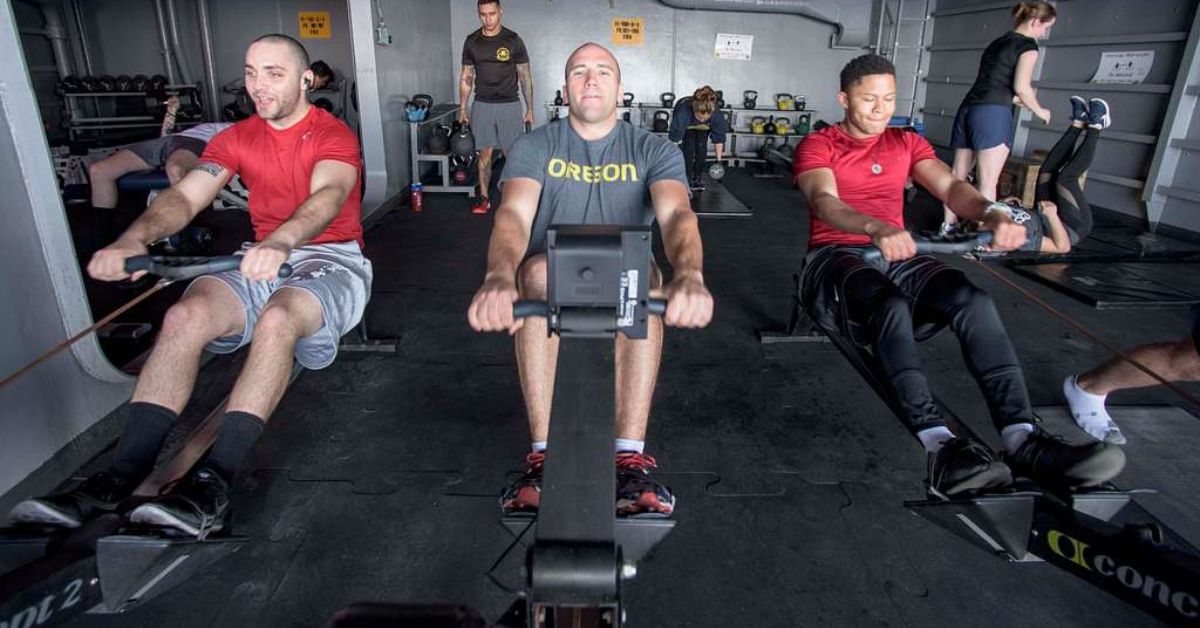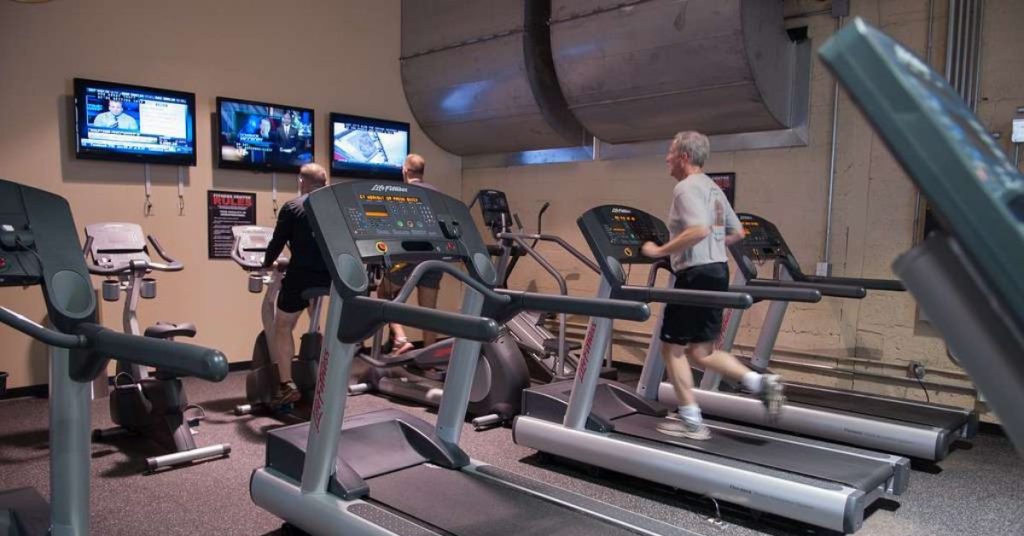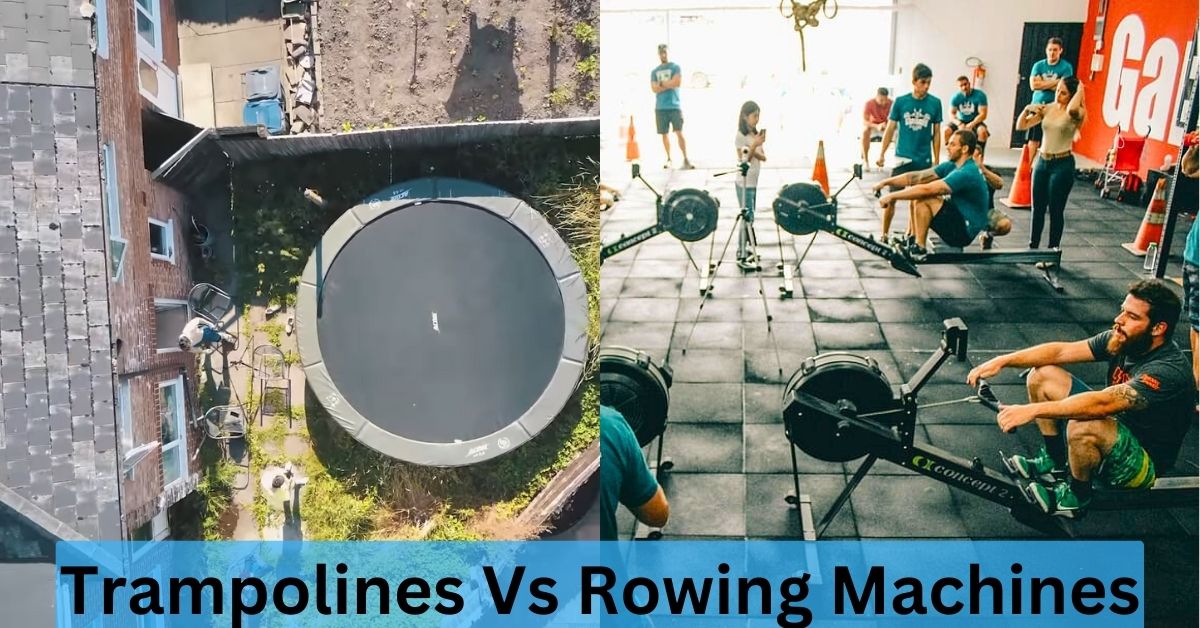Regarding fitness equipment, trampolines, and rowing machines have gained popularity among fitness enthusiasts seeking effective and enjoyable ways to stay in shape.
Both options offer unique benefits and cater to different fitness goals, making them appealing choices for individuals with varying preferences and needs.
Trampolines, with their elastic jumping surface, provide a low-impact cardiovascular workout that engages the entire body. They offer an enjoyable way to burn calories, improve balance, and enhance coordination.
Trampolining also stimulates lymphatic flow, detoxifying and improving immune system functioning. Moreover, bouncing on a trampoline can be fun for individuals of all ages, making it a versatile fitness tool.
On the other hand, rowing machines provide a full-body workout, engaging muscles in the arms, legs, and core. Rowing mimics the action of rowing a boat, offering a low-impact but high-intensity exercise that improves cardiovascular endurance, strengthens muscles, and enhances overall fitness.
Rowing machines are particularly beneficial for those seeking to build strength and endurance, burn calories, and improve posture.
In this comparison between trampolines and rowing machines, we will explore the unique features, benefits, and considerations to help you decide which fitness equipment suits your fitness goals and preferences.
So, whether you prefer the thrill of bouncing or the power of rowing, let’s dive into the world of trampolines and rowing machines to discover the perfect workout tool for you.
Trampolines vs rowing machines: Trampolines provide a fun, low-impact cardio workout while rowing machines offer a full-body, high-intensity exercise. Both have unique benefits to suit different fitness goals and preferences.
Features and Mechanics of Trampolines

Trampolines are recreational devices with a strong, flexible fabric sheet (the trampoline bed) stretched tightly over a metal frame with coiled springs.
Using these springs, the trampoline bed is attached to the frame, allowing users to bounce and perform various acrobatic movements.
Trampolines come in various shapes and sizes, including round, rectangular, and square, with different weight capacities and tension levels.
Health Benefits of Using a Trampoline
Using a trampoline offers several notable health benefits. Let’s explore them in more detail:
Cardiovascular Exercise:
Bouncing on a trampoline is an excellent cardiovascular workout. The repetitive jumping motion increases the heart rate, improving blood circulation and enhancing cardiovascular fitness. Regular trampoline use can contribute to a healthier heart and improved overall endurance.
Improved Balance and Coordination:
Trampolining requires coordination and control to maintain balance while bouncing. The constant adjustments and movements on the trampoline bed engage the muscles responsible for balance and coordination. Over time, users develop better motor skills, stability, and spatial awareness.
Increased Flexibility:
Jumping on a trampoline involves stretching and contracting muscles, which helps to improve flexibility. The constant bouncing and various positions and movements challenge different muscle groups, promoting a wider range of motion and increased flexibility.
Fun and Enjoyment of Trampoline Use
Trampolining is an effective workout and a source of immense fun and enjoyment. The feeling of weightlessness and the exhilaration of bouncing high in the air can be incredibly thrilling. Trampolines allow individuals of all ages to engage in playful activities and enjoy the freedom of defying gravity.
Children especially find trampolines fascinating, and jumping on one can be a great way to encourage them to stay active and embrace physical exercise.
Additionally, trampolines can be a source of entertainment during social gatherings, as friends and family members can join in and have a blast together.
Safety Concerns and Precautions
While trampolines offer numerous health and recreational benefits, it is crucial to prioritize safety to prevent potential injuries. Here are some important safety concerns and precautions to keep in mind:
Supervision: It is essential to have adult supervision, especially for young children, while using a trampoline. Supervisors can ensure that
Proper Techniques: Users should know the correct techniques for jumping and landing on a trampoline. This includes bending the knees and using controlled movements. Improper techniques, such as landing on the knees or back, can lead to injuries.
Safety Accessories: Trampolines should be equipped with safety accessories, such as safety nets, padding, and enclosure systems. Safety nets prevent users from bouncing off the trampoline, while padding covers the frame and springs to reduce the risk of impact injuries.
Maintenance and Inspection: Regularly inspect the trampoline for any wear and tear, loose springs, or damaged components. Proper maintenance ensures the trampoline remains safe and functional.
One User at a Time: Allowing only one person on the trampoline at a time is recommended to avoid collisions and accidents. Multiple users can lead to unexpected impacts and an increased risk of injury.
By following these safety concerns and precautions, users can significantly reduce the risk of injuries and enjoy trampolining safely and responsibly.
Design and Functionality of Rowing Machines
Rowing machines, also known as ergometers or rowers, are exercise equipment designed to simulate the motion of rowing a boat. They consist of a seat, footrests, a handlebar or oar-like grips, and a resistance mechanism. Various methods, such as air, water, magnetic, or hydraulic systems, can provide resistance.
The user sits on the seat and secures their feet on the footrests. They then grip the handlebar or oar-like grips with their hands. The rowing motion involves pushing with the legs, followed by a pullback with the arms and a return to the starting position.
The resistance mechanism provides resistance against the user’s effort, simulating the resistance encountered when rowing in the water.
Physical Benefits of Rowing

Rowing offers a wide range of physical benefits that contribute to overall fitness and well-being.
Whether you row on the water or use a rowing machine, this full-body exercise engages multiple muscle groups and provides an efficient cardiovascular workout.
Here are some of the key physical benefits of rowing:
Full-Body Workout:
Rowing machines offer a comprehensive full-body workout. The rowing motion engages multiple muscle groups simultaneously, including the legs, glutes, core, back, shoulders, and arms.
This coordinated effort results in a balanced and effective workout that targets both the upper and lower body.
Muscle Strengthening:
Rowing is a resistance exercise that builds and tones muscles. The legs drive the movement, providing a powerful workout for the quadriceps, hamstrings, and calf muscles.
The core muscles are engaged to maintain stability and control, while the back, shoulders, and arms are strengthened during the pulling phase of the rowing stroke. Regular rowing can lead to improved muscle strength and endurance throughout the body.
Calorie Burning: Rowing is a highly effective calorie-burning activity. The combination of full-body engagement and cardiovascular effort leads to increased calorie expenditure. Rowing machines provide a high-intensity workout to help with weight loss or weight management goals.
Cardiovascular Fitness:
Rowing is an excellent cardiovascular exercise that promotes heart health and improves overall fitness. The continuous rowing motion elevates the heart rate, increasing oxygen uptake and enhancing lung capacity.
Regular rowing sessions can improve cardiovascular endurance and promote a healthier cardiovascular system.
Low-Impact Exercise
Rowing machines offer a low-impact exercise option that is gentle on the joints. The seated position and fluid rowing motion reduce the impact on the knees, hips, and ankles compared to high-impact exercises like running or jumping.
This makes rowing machines ideal for individuals with joint issues, arthritis, or those recovering from injuries. The low-impact nature of rowing allows for a challenging workout without putting excessive stress on the joints.
The Versatility of Rowing Machines
Rowing machines are highly versatile in terms of resistance levels and training programs. Most rowing machines have adjustable resistance settings, allowing users to customize the intensity of their workouts.
Some machines use air or water resistance, where the resistance level increases as the user rows harder or faster. Others use magnetic or hydraulic systems that allow for precise resistance adjustments.
Rowing machines also offer various training programs to suit different fitness goals and preferences. They may include preset workouts with specific time or distance goals, interval training programs, or the option to create custom workouts.
This versatility ensures that rowing machines can accommodate users of different fitness levels and provide progressive challenges as fitness improves.
Trampolines vs Rowing Machines: Expect Comparison
Regarding cardiovascular exercises, trampolines and rowing machines are two popular options that provide a great workout. While trampolines offer a fun and dynamic way of pumping the heart, rowing machines provide a low-impact, full-body workout.
In this comparison, we will examine the cardiovascular benefits, impact on muscle groups and overall body toning, calorie-burning potential, joint health and injury risks, and trampolines and rowing machines’ cost and space requirements.
Cardiovascular Benefits:

Both trampolines and rowing machines offer excellent cardiovascular benefits but in slightly different ways.
Trampolining is a high-impact exercise that involves continuous bouncing, which increases heart rate, improves circulation, and strengthens the heart.
It provides a fun way to get the blood flowing and boosts cardiovascular fitness.
On the other hand, rowing machines offer a low-impact, full-body workout that engages the cardiovascular system. Rowing involves rhythmic movements that utilize large muscle groups and increase heart rate, improving cardiovascular endurance and overall fitness.
While trampolines provide a more dynamic and playful cardiovascular workout, rowing machines offer a controlled and targeted approach.
Impact on Muscle Groups and Overall Body Toning:
Trampolines and rowing machines both engage multiple muscle groups and contribute to overall body toning, albeit in different ways. Trampolining primarily targets the lower body, including the legs, glutes, and core muscles.
The repeated bouncing and jumping motions help to strengthen and tone these areas, resulting in improved muscle definition and a toned physique. Trampolining also engages the upper body to a certain extent, particularly the arms and shoulders, as they maintain balance and control during jumps.
On the other hand, rowing machines provide a full-body workout that engages almost every major muscle group. Rowing involves a pushing and pulling motion that targets the back, shoulders, arms, and chest while also engaging the core, legs, and glutes.
This comprehensive muscle engagement improves muscle strength, endurance, and overall body toning. Rowing machines are particularly effective at developing the back and shoulder muscles, promoting good posture, and preventing imbalances.
Calorie-Burning Potential:
Both trampolines and rowing machines are effective calorie-burning exercises with the potential to help in weight loss and management. Trampolining is a high-intensity activity that can burn a significant number of calories in a short period.
7 The continuous jumping and bouncing motions increase heart rate and metabolism, leading to enhanced calorie burning. The exact number of calories burned during trampolining depends on factors such as intensity, duration, and individual body composition.
Similarly, rowing machines provide a high-intensity cardiovascular workout that burns many calories. Rowing engages multiple muscle groups simultaneously, which increases energy expenditure.
The resistance settings on rowing machines can be adjusted to vary the intensity and challenge level, allowing individuals to customize their workouts to maximize calorie burning.
Again, the number of calories burned during rowing depends on various factors such as intensity, duration, and individual fitness level.
Impact on Joint Health and Injury Risks:
When considering joint health and injury risks, rowing machines have an advantage over trampolines. Trampolines, especially when used improperly or without adequate precautions, can pose a higher risk of joint injuries, such as sprained ankles, twisted knees, or even fractures.
The high-impact nature of trampolining puts stress on the joints and can lead to overuse injuries if not performed with proper technique and moderation. It is essential to use a trampoline with safety measures like padding and enclosures and follow guidelines to reduce the risk of injuries.
On the other hand, row machines offer a low-impact exercise option that is gentle on the joints. The smooth gliding motion of rowing minimizes joint stress while still providing an effective workout. This makes rowing machines suitable for individuals with joint issues or those seeking a low-impact exercise alternative.
Cost and Space Requirements:
When considering the cost and space requirements, trampolines and rowing machines have different considerations. Trampolines can vary significantly in price, depending on the size, quality, and features.
There are trampolines available at different price points, ranging from budget-friendly options to higher-end models.
Additionally, trampolines require a dedicated outdoor space, preferably with safety measures such as padding and enclosures.
On the other hand, rowing machines also have a wide range of prices, depending on the type and features. Various types of rowing machines are available, including hydraulic, magnetic, air, and water resistance models, each with its own price range.
Rowing machines can be compact and foldable, making them suitable for home use and requiring less space than trampolines.
Choosing the Right Option:
When deciding between trampolines and rowing machines, it is important to consider various factors that are specific to your personal preferences, fitness goals, individual fitness levels, health conditions, available space, budget, and convenience.
Making an informed decision will ensure that you choose the exercise option that aligns with your needs and maximizes your chances of success. Here are some key considerations to help you make the right choice:
Consider Personal Preferences and Fitness Goals:
Your personal preferences and fitness goals should significantly determine whether a trampoline or rowing machine is right for you. Think about the type of exercise you enjoy and find motivating.
If you prefer activities that are fun, dynamic, and allow for creativity, trampolining might be a suitable choice. On the other hand, if you prefer structured workouts and a full-body exercise experience, a rowing machine may be more appealing.
Additionally, consider your specific fitness goals. Trampolining can provide that sense of fun and excitement if your primary objective is to improve cardiovascular fitness and have an enjoyable workout experience.
However, a rowing machine can offer a more targeted and comprehensive workout if you aim for overall body toning, muscle development, and calorie burning.
Discuss Individual Fitness Levels and Health Conditions:

Another crucial consideration is your individual fitness level and any existing health conditions. Trampolining is generally considered a moderate-to-high-intensity exercise that can be physically demanding.
Trampolining might not be your best choice if you have joint issues, balance problems, or pre-existing medical conditions that may limit your ability to jump and bounce safely.
Rowing machines, on the other hand, provide a low-impact exercise option that is suitable for individuals of different fitness levels and those with joint concerns.
The adjustable resistance settings on rowing machines allow you to customize the intensity of your workout, making it accessible for beginners and challenging enough for advanced users.
It is always advisable to consult with your healthcare provider or a qualified fitness professional if you have any concerns about your fitness level or any underlying health conditions. They can provide personalized advice and help you make informed decisions based on your circumstances.
Assess Available Space, Budget, and Convenience Factors:
Consider the space you have available for exercise equipment and your budgetary constraints. Trampolines typically require a dedicated outdoor area with ample space for safe bouncing.
The size of trampolines can vary, so make sure you have enough room to accommodate the specific model you are considering.
Additionally, factor in the cost of purchasing a trampoline and any additional safety features such as enclosures and padding.
Rowing machines, however, can be a more space-efficient option, especially if you choose a foldable or compact model. They can be used indoors and do not require as much dedicated space as trampolines.
Consider the available space in your home and whether you have a designated area for exercise equipment. Additionally, assess your budget and research different rowing machine models to find one that fits within your financial means.
Convenience is another factor to consider. Think about your daily routine and how easily you can incorporate either option into your lifestyle. Consider factors such as transportation, storage, and setup requirements.
Choose an exercise option that aligns with your convenience preferences to ensure consistency and adherence to your fitness routine.
Suggest Consulting a Fitness Professional or Healthcare Provider:
When deciding on whether to choose a trampoline or a rowing machine, it is always a good idea to seek professional advice. Consulting with a fitness professional or healthcare provider can provide personalized guidance based on your individual needs, goals, and health considerations.
They can assess your fitness level, provide insights into potential risks or limitations, and help you make an informed decision prioritizing your well-being.
These professionals can also guide you in proper technique and form to minimize the risk of injury and maximize the benefits of your chosen exercise option. Their expertise will ensure that you embark on a fitness journey that is safe, effective, and enjoyable.
FAQs
Q:1 What are the main differences between trampolines and rowing machines?
Trampolines and rowing machines are exercise equipment, but they offer different workouts. Trampolines provide a low-impact cardiovascular workout while emphasizing balance and coordination.
On the other hand, row machines offer a full-body, high-intensity workout that simultaneously targets multiple muscle groups.
Q:2 Which one is better for weight loss: trampolines or rowing machines?
Both trampolines and rowing machines can aid in weight loss, but rowing machines are generally more effective in burning calories and promoting weight loss.
Rowing engages the muscles of the entire body and can provide a more intense cardiovascular workout, leading to greater calorie expenditure.
Q:3 Are trampolines suitable for people with joint problems?
Trampolines can be a good option for people with joint problems because they offer a low-impact workout. The bouncing motion reduces the stress on joints, making it easier on the knees, ankles, and hips than high-impact exercises like running.
However, it’s always a good idea to consult with a healthcare professional before starting any exercise regimen, especially if you have pre-existing joint issues.
Q:4 Can rowing machines help improve cardiovascular fitness?
Yes, rowing machines are excellent for improving cardiovascular fitness. They provide a full-body workout that engages major muscle groups while elevating the heart rate. Regular rowing sessions can enhance endurance, increase lung capacity, and improve overall cardiovascular health.
Q:5 Which equipment offers better muscle toning: trampolines or rowing machines?
Both trampolines and rowing machines can contribute to muscle toning, but rowing machines are particularly effective in this regard. Rowing engages the muscles of the legs, core, back, and arms, providing a comprehensive full-body workout.
Trampolines primarily target the leg muscles but can also engage the core and improve overall muscle tone.
Q:6 Can trampolines or rowing machines be used for cross-training?
Yes, both trampolines and rowing machines can be incorporated into a cross-training routine. Trampolines offer a different form of cardiovascular exercise and can complement other activities by improving balance, coordination, and leg strength.
Rowing machines provide an intense full-body workout that enhances overall fitness and is an excellent addition to a cross-training program.
Q:7 Can trampolines or rowing machines help with stress relief?
Both trampolines and rowing machines can contribute to stress relief. Trampolining can be a fun exercise that releases endorphins and helps improve mood. The rhythmic motion of rowing combined with the release of physical exertion can also promote stress reduction and relaxation.
Regardless of the equipment, regular exercise has been shown to positively affect stress management and overall mental well-being.
Conclusion
In conclusion, both options offer unique features and health benefits when comparing trampolines and rowing machines. Trampolines provide an enjoyable way to engage in cardiovascular exercise, improve balance and coordination, increase flexibility, and strengthen muscles. However, safety concerns and precautions should be considered to avoid injuries.
On the other hand, rowing machines offer a full-body workout that targets various muscle groups, strengthens muscles, improves cardiovascular fitness, and provides a low-impact exercise option. They are versatile in terms of workout intensity and can be adjusted to suit individual fitness levels and goals.
When comparing the two options, considerations should be made regarding cardiovascular benefits, impact on muscle groups and overall body toning, calorie-burning potential, joint health, injury risks, cost, space requirements, personal preferences, fitness goals, and available space and budget.
Consulting a fitness professional or healthcare provider is recommended to ensure that the chosen exercise equipment aligns with individual fitness levels and health conditions.
Ultimately, the choice between trampolines and rowing machines depends on personal preferences, fitness goals, available space, budget, and individual health conditions. It is important to make an informed decision and choose the option that best suits one’s needs for a safe and effective exercise routine.
After reading this detailed guide, We hope you will understand trampolines and rowing machines. If you have any questions, please feel free to leave a comment below!

